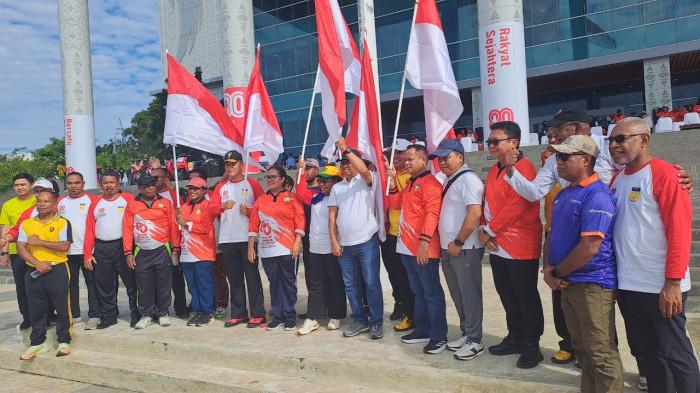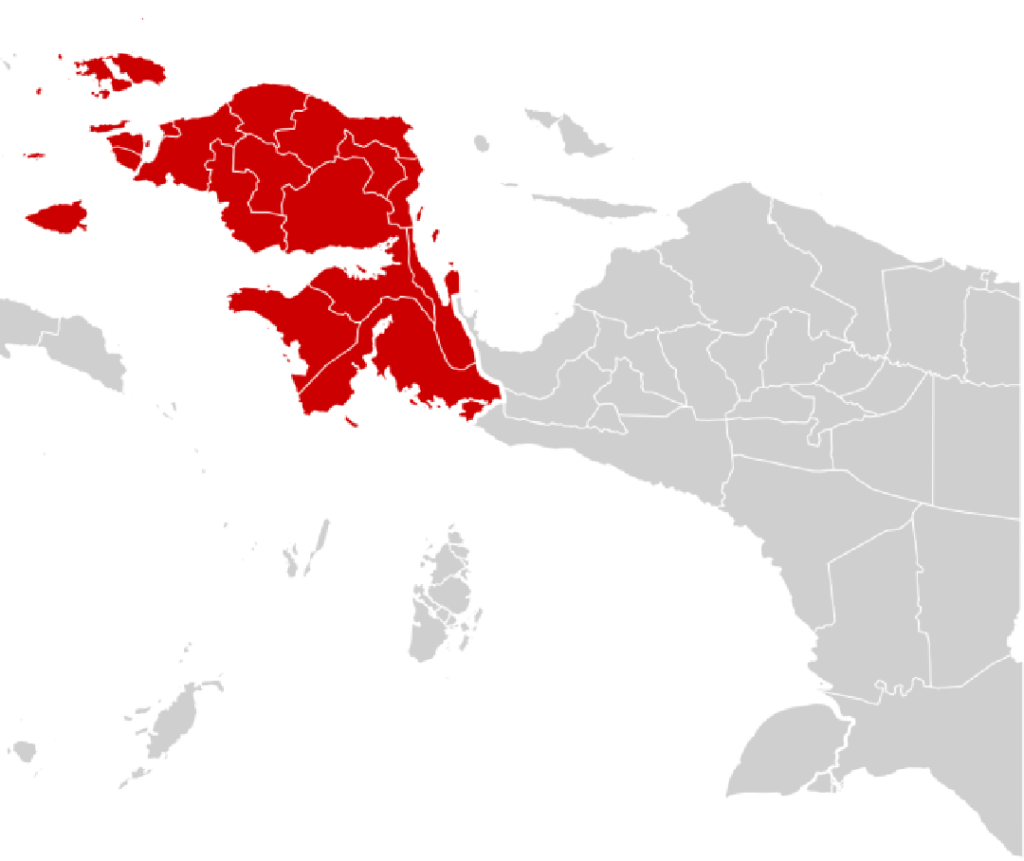In the highlands and along the coastal towns of Papua, a sea of red and white has begun to rise with the morning sun. Flags flutter on rooftops, roadside stalls, motorbikes, and schoolyards. As Indonesia approaches its 80th Independence Day on August 17, 2025, the spirit of Merah Putih is sweeping across the easternmost provinces of the archipelago—nowhere more vividly than in Papua. What began as a symbolic gesture has evolved into a grassroots movement: from festive community sports and patriotic marches to the mass distribution of tens of thousands of flags. For many Papuans, this moment is more than a ceremonial milestone. It is a powerful expression of unity, history, and national identity—one that harks back to 1969, when Papua officially returned to the fold of the Republic of Indonesia through the Pepera, or Act of Free Choice.
Morning Marches and Unity in Motion
On a brisk Saturday morning on July 31, 2025, the streets of Jayapura burst into life with laughter and footsteps. Hundreds of residents joined a mass fun walk (jalan santai) and mass blood donation, part of the lead-up festivities to commemorate the 80th anniversary of independence. Organized by local government and security forces, the event wasn’t just about physical activity—it was a statement of togetherness.
“The atmosphere was filled with excitement,” said Chief Commissioner Ignatius Benny Ady Prabowo. “This event fosters public unity and reinforces the spirit of nationalism.”
Children marched with tiny flags, their faces painted in red and white, while parents waved to passing motorcades adorned with banners bearing the number “80” and the Garuda Pancasila. Music played from portable speakers, mixing traditional Papuan drums with patriotic Indonesian songs. It was a carnival of national pride.
A Tidal Wave of Red and White
In a massive show of solidarity, the Papua Provincial Government has been distributing thousands of Indonesian flags to citizens. Over 80,000 Merah Putih (Red and White) flags have already been handed out, with the aim of draping neighborhoods, villages, and even remote rural areas in a blanket of red and white.
“We want every corner of Papua to feel the spirit of independence,” said Acting Secretary of Papua Province Suzana Wanggai. “The flag is a symbol of unity, reminding us of our shared destiny as Indonesians.”
Just days ago, local officials held a ceremony in Jayapura to distribute 1,000 additional flags to residents, part of the final push to saturate the province with patriotic color ahead of August 17. The initiative has been welcomed enthusiastically by community leaders, school principals, and civil society groups who see it as a tool for nation-building.
A Complex but Enduring Connection: Papua and the Republic of Indonesia
This year’s Independence Day commemoration also stirs deep historical memories. In 1969, under the supervision of the United Nations, the Act of Free Choice was conducted in Papua—then referred to as West Irian. In that process, 1,025 Papuan representatives voted unanimously for integration with Indonesia, a decision that formalized the region’s status as part of the Republic of Indonesia.
While the legitimacy and fairness of the Pepera have long been the subject of international debate and domestic tension, it remains a pivotal chapter in Indonesia’s national narrative. For some, it was a moment of unification; for others, a moment of lost sovereignty. Yet for many contemporary Papuans, especially among younger generations, the question is not about rehashing history but shaping the future.
“History is important, but what we do now matters more,” said Yohanes Mabel, a youth leader from Wamena. “We want development, peace, and respect—for our identity as Papuans and our role as Indonesians.”
Youth-Led Patriotism: Sports and Celebration
Across Papua, community leaders and law enforcement agencies are leveraging youth enthusiasm to foster patriotism. In multiple regencies, sports activities such as football matches, relay races, and volleyball tournaments have been organized to engage students and young adults.
A recent joint sports day involving police officers, teachers, and youth groups brought hundreds together in a symbolic gesture of cooperation and equality. Officers jogged alongside students, teachers cheered on local teams, and small ceremonies honored the best athletes. Such events, while seemingly routine, carry significant meaning in regions where social cohesion has often been strained by economic inequality and historical grievances.
“These activities strengthen trust between communities and the government,” said Inspector Elieser Renmaur, who oversaw a recent public event in Keerom District. “Sports bring people together in ways that speeches and policies often cannot.”
The Flag as a Bridge
The Merah Putih, flown from every flagpole in Papua during August, becomes more than just a national emblem. For some, it is a reconciliation gesture—a way to bridge divisions and signal inclusion.
In places like Nabire, Timika, and Biak, residents have begun their own independent efforts to fly the flag high. Some villages have initiated mini-parades and singing competitions themed around Indonesia’s independence. Others have used the occasion to educate children about national heroes and the constitution.
“I taught my students about Soekarno and Hatta this week,” said Rosa Enumbi, a schoolteacher in Paniai. “Some of them didn’t know the full story of Indonesia’s independence. Now, they sing ‘Indonesia Raya’ with pride.”
A New Chapter Ahead?
While challenges remain—such as access to education, healthcare disparities, and political dialogue—many Papuans see the 80th Independence Day as a turning point. The increasing involvement of local youth, indigenous leaders, and civil society groups in national events hints at a slow but meaningful shift in engagement.
Experts argue that visibility matters. “When Papuan communities are included in national narratives, not just as a periphery but as central actors, it helps redefine what Indonesia means,” said Dr. Marcellinus Kambuaya, a political analyst from Cenderawasih University. “These Independence Day celebrations show that nation-building is not a one-way street—it requires mutual recognition.”
Looking Forward: A Shared Horizon
As August 17 approaches, more events are scheduled across Papua: flag-raising ceremonies, cultural festivals, prayer services, and civic education forums. Government buildings have been repainted, town squares cleaned, and traditional markets adorned with Independence Day banners.
In Mimika Regency, a special night vigil and fireworks display is planned for the eve of Independence Day, organized by both the regency government and local churches. “It will be a moment to pray for unity and peace,” said Pastor Mathius Ohee, a respected religious figure from Sentani.
Whether one looks at the celebrations as a reaffirmation of national pride, a symbol of progress, or a call for greater justice and inclusivity, one thing is certain: Papua is preparing to celebrate not just a national holiday but also its place within the story of a nation that continues to evolve.
As the Merah Putih soars above the emerald hills and golden coasts of Papua, it carries with it a promise—of recognition, of respect, and of a shared Indonesian future.
Conclusion
The preparations for Indonesia’s 80th Independence Day in Papua highlight a growing spirit of unity, patriotism, and participation among Papuan communities. Through events like fun walks, sports activities, and widespread flag distribution, Papuans are asserting both their regional identity and national belonging. While the historical integration of Papua into Indonesia in 1969 remains complex and debated, current celebrations signal a desire among many Papuans—especially the youth—to move forward and actively shape their place within the Republic of Indonesia. The Merah Putih flying across Papua today is more than a flag; it symbolizes hope, recognition, and the aspiration for a future built on mutual respect and inclusivity.


